Day Laborer Space
The last time I noticed Public Architecture’s renderings for a “Day Laborer Station” the design appeared to be much more mobile, temporary, light weight - less grounded. Quite literally it had a hitch on it, flappable walls that looked like flying instruments, and an innerspace collective cockpit - all which I liked. The new design appears to be more fastened now to the context, embedded in it, and maybe taken on a brand new air of aesthetic viability.
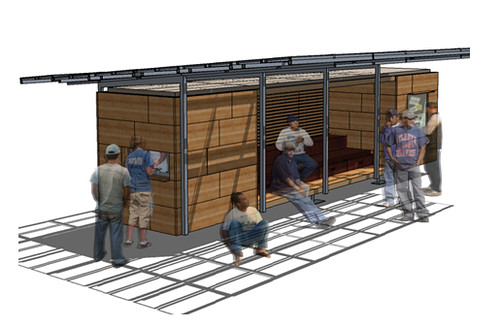
Let’s face it, trying to get cities to adopt 'day-laborer stations' isn’t the easiest of battles right now. While providing responsible day laborer space makes total sense, it also forces a recognition of the U.S.'s cultural underhanded treatment of day laborers, it sanctions their contribution to the economy, and gets cities to plan appropriately for their deserved places in the labor market. But instead of waiting for immigration to boil down this seems like the most crucial moment in American day-laborer history to mobilze and try to define their own architectural niches - to self-urbanize, self-legitimize. Preserve the architecural rights of mankind - assume a shell and organize. And that's what it is: a kind of politically binded borderlands' nomadic urbanism.
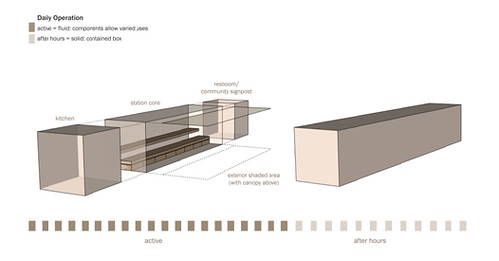
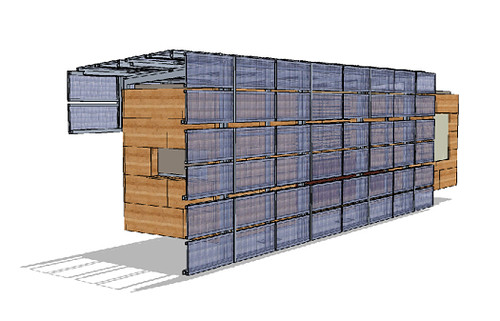
The new design wants to appear less temporary and to position itself as a more permanent part of any future urban solution. Though it says it can be deployed it appears this latest prototype would remain in place overnight and therefore not move at all. Which I think is an important progression in gaining municipal acceptance, promoting a fundamental spatial dignity for day laborers that won’t be easily swept away, and could be the first step in building a longer range structural institution for the day laborer community.
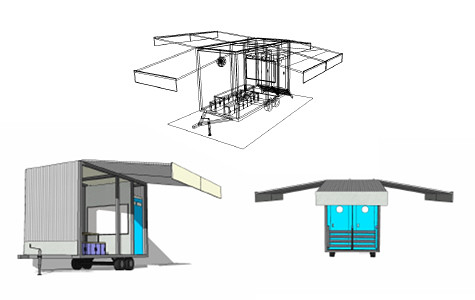
But I don’t think the other design (as pictured above) has become outgrown or made any less useful, either. I can imagine plenty circumstances where the previous rig might still be optimal. What if neighborhood groups don’t want a permanent installation on or near their block? What if weather conditions shift the day laborer locations temporarily, or road conditions, an accident. Or any other unforeseeable settlement disruptions. What if normal location access is decreased by something, a new construction zone, f.e., a street event, and workers are forced to relocate to more visible locations in inhospitable weather condition? Or, suppose there are only a few of these structures at first, and determining their ideal location requires movement and some location testing? I guess I see uses for both structures, maybe in different stages of exploration in neighborhoods, and in general want to see the informal labor market flooded with them.
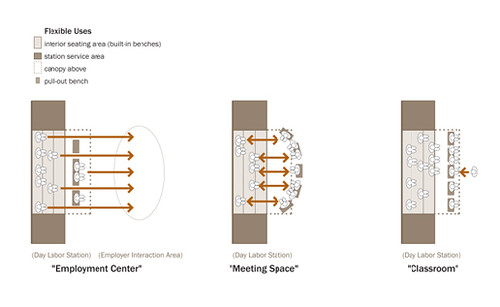
I always thought the potential station had the unique capability to serve as a multi-use space for perhaps other communities, too, so that not only could the day laborers find this structure useful and adaptive given several unique needs, but it could also allow them to branch out with other communities who may share similar challenges of mobilizing in the streets. So the day laborer station becomes a valuable place for expanding social networks and bridging multiple communities who require use of public space for their livelihoods. So it is great to hear that the new design “will be flexible enough to serve various uses, including as an employment center, meeting space, and classroom.”
Anyway, I am pretty excited to see this project fulfilling its use some day here in the San Francisco Bay Area where there is tremendous need, or wherever it may happen to enter the civil domain. The Day Laborer Station prototype will actually be on display in May 2007 at the Smithsonian’s Cooper-Hewitt, National Design Museum in the exhibition “Design for the Other 90%,” a showcase for humanitarian design that sounds great. The show “highlights the growing trend among designers to develop solutions that address basic needs for the vast majority of the world’s population not traditionally serviced by professional designers.” So if you are in the area or just want to lock it down now - keep it in mind.
According to this recently printed preview, it will be organized according to different sectors of humanitarian focus, like food, water, shelter, health and sanitation, education, energy and transportation. Featured will be design solutions such as:
» the LifeStraw, a mobile personal water purification tool.
» furniture recycled from hurricane debris and produced by the Katrina Furniture Project.
» the Pot-in-Pot Cooler, a storage container that doubles the amount of crops saved while extending their shelf life.
» the Big Boda Load Carrying Bicycle, which can easily carry hundreds of pounds of cargo or two additional passengers at a substantially lower cost than other forms of human-powered utility vehicles.
» MoneyMaker Pumps, which families can use to irrigate fruits and vegetables during the dry season, allowing greater crop yields year-round.
» Nicholas Negroponte’s One Laptop per Child project, an inexpensive, universal laptop computer to be used as an educational tool for children.

Let’s face it, trying to get cities to adopt 'day-laborer stations' isn’t the easiest of battles right now. While providing responsible day laborer space makes total sense, it also forces a recognition of the U.S.'s cultural underhanded treatment of day laborers, it sanctions their contribution to the economy, and gets cities to plan appropriately for their deserved places in the labor market. But instead of waiting for immigration to boil down this seems like the most crucial moment in American day-laborer history to mobilze and try to define their own architectural niches - to self-urbanize, self-legitimize. Preserve the architecural rights of mankind - assume a shell and organize. And that's what it is: a kind of politically binded borderlands' nomadic urbanism.


The new design wants to appear less temporary and to position itself as a more permanent part of any future urban solution. Though it says it can be deployed it appears this latest prototype would remain in place overnight and therefore not move at all. Which I think is an important progression in gaining municipal acceptance, promoting a fundamental spatial dignity for day laborers that won’t be easily swept away, and could be the first step in building a longer range structural institution for the day laborer community.

But I don’t think the other design (as pictured above) has become outgrown or made any less useful, either. I can imagine plenty circumstances where the previous rig might still be optimal. What if neighborhood groups don’t want a permanent installation on or near their block? What if weather conditions shift the day laborer locations temporarily, or road conditions, an accident. Or any other unforeseeable settlement disruptions. What if normal location access is decreased by something, a new construction zone, f.e., a street event, and workers are forced to relocate to more visible locations in inhospitable weather condition? Or, suppose there are only a few of these structures at first, and determining their ideal location requires movement and some location testing? I guess I see uses for both structures, maybe in different stages of exploration in neighborhoods, and in general want to see the informal labor market flooded with them.

I always thought the potential station had the unique capability to serve as a multi-use space for perhaps other communities, too, so that not only could the day laborers find this structure useful and adaptive given several unique needs, but it could also allow them to branch out with other communities who may share similar challenges of mobilizing in the streets. So the day laborer station becomes a valuable place for expanding social networks and bridging multiple communities who require use of public space for their livelihoods. So it is great to hear that the new design “will be flexible enough to serve various uses, including as an employment center, meeting space, and classroom.”
Anyway, I am pretty excited to see this project fulfilling its use some day here in the San Francisco Bay Area where there is tremendous need, or wherever it may happen to enter the civil domain. The Day Laborer Station prototype will actually be on display in May 2007 at the Smithsonian’s Cooper-Hewitt, National Design Museum in the exhibition “Design for the Other 90%,” a showcase for humanitarian design that sounds great. The show “highlights the growing trend among designers to develop solutions that address basic needs for the vast majority of the world’s population not traditionally serviced by professional designers.” So if you are in the area or just want to lock it down now - keep it in mind.
According to this recently printed preview, it will be organized according to different sectors of humanitarian focus, like food, water, shelter, health and sanitation, education, energy and transportation. Featured will be design solutions such as:
» the LifeStraw, a mobile personal water purification tool.
» furniture recycled from hurricane debris and produced by the Katrina Furniture Project.
» the Pot-in-Pot Cooler, a storage container that doubles the amount of crops saved while extending their shelf life.
» the Big Boda Load Carrying Bicycle, which can easily carry hundreds of pounds of cargo or two additional passengers at a substantially lower cost than other forms of human-powered utility vehicles.
» MoneyMaker Pumps, which families can use to irrigate fruits and vegetables during the dry season, allowing greater crop yields year-round.
» Nicholas Negroponte’s One Laptop per Child project, an inexpensive, universal laptop computer to be used as an educational tool for children.







0 Comments:
Post a Comment
<< Home